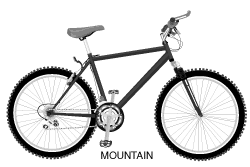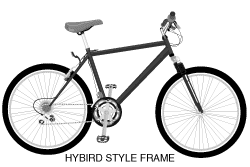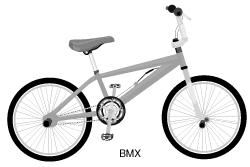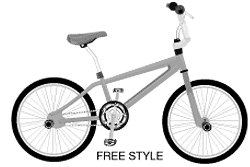Bike Styles
Bikes come in different styles for different types of riding. Use our guide to find your best design.
How To Buy The Right Bike
The type of riding you plan to do should determine the style of bike you buy. You should consider whether you will be riding primarily on pavement or on dirt roads, and whether you ride fast from point to point or just want to cruise along. Another consideration is whether you want your bike mainly for transportation, competitions, or just having fun. Also think about how long you plan to keep your bike, your body size, and whether the bike will be used for commuting, recreation, or racing.

Buying a Mountain Bike
Mountain Bikes are designed for riding over rugged terrain.
Features
- Mountain bikes have strong frames, durable wheels, upright handlebars, and strong brakes
- They also have low gears to help you go up hills, pedal through mud, and contend with roots, rocks and bumps
- They tend to be heavier than road and hybrid bikes, but are stronger overall and built to take more abuse
- The brakes are strong and have extra clearance to reduce mud build-up
- Many models feature front suspension systems built into the fork, and rear suspension is also becoming more common. Suspension increases comfort and improves control over rough ground.
Determining Your Ability Level
- Entry-level models are good for beginning riders who plan to ride primarily on bike paths, but may venture onto a dirt road or rocky trail
- Front suspension bikes are suitable for intermediate riders who spend most of their time off-road, but may also venture onto bike paths or packed dirt roads and trails
- Full-suspension cross-country models are designed for serious off-road riding

Buying a Road or Hybrid Bike
Road bikes are designed to be ridden only on pavement.
Features
- Road bikes
- Road bikes have light frames, drop or racing style handlebars, and narrow, high-pressure tires
- They are designed for speed, efficiency, and long distance
- Sport and touring bikes (sub-categories of road bikes)
- Sport and touring bikes have the same features as road bikes, and may also offer three chain rings (granny gears) for easy pedaling, as well as special frame fittings for fenders and racks
- Hybrid bikes (cross bikes)
- Hybrid bikes combine the features of mountain and road bikes
- Like mountain bikes, they have a wide gear ratio and upright handlebars
- Like road bikes, they also have narrower tires suited to riding on pavement
- Hybrids are good for casual road riding, commuting, and for riding on smooth dirt roads or trails.
- They are not as fast as traditional road bikes, and cannot handle rough terrain as well as mountain bikes
- Comfort bikes
- Comfort bikes feature upright handlebars and wide, padded seats
- They also have wide, smooth-riding tires, hand or coaster brakes, and are great for cruising around parks and beaches
Determining your ability level
- Road bikes are good for serious riders who like to go fast and far
- Sport bikes are good for recreational riders who also want some performance attributes
- Touring bikes are designed for riders who want to carry loads, such as racks and panniers (special bike bags), over long distances
- Hybrid models are designed for riders that want the lightness of a road bike and the durability and comfort of a mountain bike. Because of their versatility, hybrids are especially suited to recreational riders and commuters.
- Comfort bikes are good for beginning and recreational riders, and for those who enjoy casual cruising in beach, park or neighborhood environments. They're also great for family rides.

Buying a BMX Bike
BMX stands for bicycle motorcross.
Features
- BMX bikes are designed to be ridden and raced over prepared obstacle courses (usually through woods or around a dirt track), and are patterned after motorcycle motocross
- BMX bikes look similar to mountain bikes, but have smaller wheels and frames
Determining your ability level
- BMX bikes are not just for kids, but because they are so rugged, they are great for young riders who have not graduated beyond the curb-hopping, pothole-aiming phase of their careers

Buying a Freestyle Bike
Freestyle bikes are designed for doing tricks on the ground, off a ramp or in a half-pipe.
Features
- Freestyle frames are small and sturdy, and closely resemble their BMX brethren
- Features may include front and rear pegs (which riders can stand on while performing tricks), and a rotor that allows the handlebars to spin 360 degrees without the brake cables getting tangled or broken
Determining your ability level
- Freestyle bikes are specifically designed for daredevil antics and are not ideal for extremely young children
- Because of the nature of freestyle riding, knee and elbow pads, as well as a helmet, are highly recommended
Buying a Chopper Bike
Chopper-style bikes are based on chopper motorcycles with an extended fork and low-riding style.
Features
- Motorcycle-inspired styling.
- Often include a wide rear tire, a large padded seat and extended handlebars.
Determining your ability level
- Chopper bikes offer a relaxed riding position that's designed for easy riding and cruising. These bikes are not designed for off-road riding.
Bike Frame Materials
In general, the lighter and stronger the frame and the better the components the more expensive the bike. The feel of a bike is largely attributable to its frame material.
Steel
The most commonly used material in bike frames is steel.
- Carbon or high-tensile steel
- Strong and long lasting, but it's also heavy
- It is most suitable for kids' bikes and recreational or comfort-style bikes
- Chromoly (chrome molybdenum) steel
- Light, strong, responsive, and gives a somewhat resilient, supple ride
- It is used in both recreational and higher-end bikes in all categories
Aluminum alloy
- Light, stiff and strong
- It is not as forgiving as chromoly, but it is lighter than steel
- It is good for riders who want lightness and who don't mind a slightly rougher ride
Titanium
- Very light, tremendously strong, and is more resilient than steel
- Resists fatigue and corrosion and therefore needs no paint
- Titanium is fairly expensive and is limited to use in high-end road and cross-country mountain bikes where performance is the primary concern
Carbon fiber
- Very tough and light and will never rust or corrode, but it's also brittle
- Metal lasts because it can bend and regain its shape. Carbon fiber can't, which is why these bikes have to be built stronger than actually needed.
- Carbon fiber is extremely expensive and is best suited for riders who want a fast, light bike with a futuristic look
- Carbon fiber is extremely expensive and is best suited for riders who want a fast, light bike with a futuristic look
Bike Frame Construction
It helps to know how a bike is put together as you take a look at all of the components.
Butting
- Butting refers to putting the material in the places that a frame will be under the most stress, which is at the ends of the tubes
- Internal butting is hidden within the tube
- External butting is an older, more expensive method of adding material to the outside of a tube
- Double butting means that as the tube is shaped, extra material is added internally at each end. This allows for reduced wall thickness which saves weight
- Triple butting saves even more weight by stepping down the material at the tube ends
Welding
- Welding refers to the method used to join frame tubes
- Many low-end and entry-level bikes have extended welds, which is an inexpensive way of adding material to the ends of the tubes
- There are three styles of welding
- TIG (Tungsten Inert Gas) welding uses the same material as the tube. Nearly all high-end bikes use this method because it's relatively inexpensive and creates a solid weld.
- Brazing joins the tubes using silver or brass
- Lugs can also be used to join the tubes